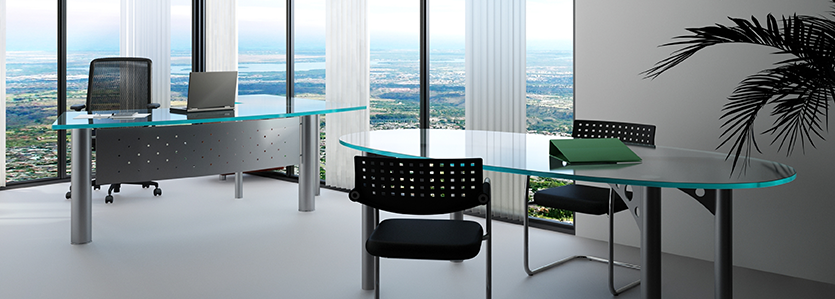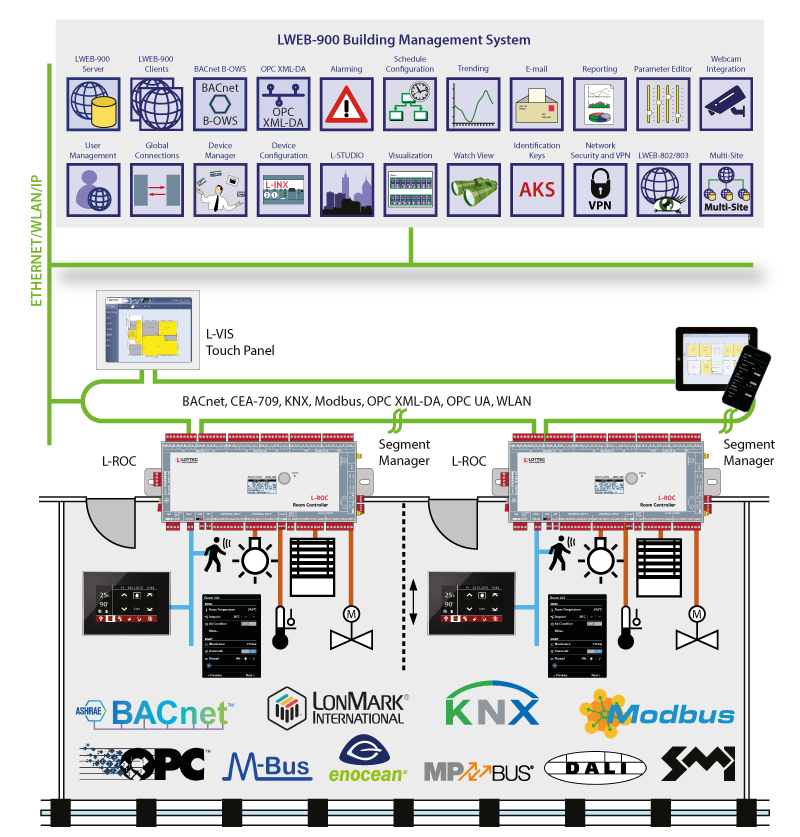
Task:
A room automation system nowadays has to be flexible enough to be adapted quickly and easily to altered room or usage conditions. The aim is to install a room automation system which integrates heating/cooling, lighting and sun blinds. At the same time it needs to be flexible and easy to use – for the end user as well as for maintenance personal. When a floor plan change is desired an operator should be capable to perform room layout changes while operation continues without sophisticated training. The end user should be able to operate the room functions via his PC. The room automation system should provide Ethernet/IP connectivity down to room level comprising standardized communication protocols.
Solution:
The L-ROC room automation system is the perfect solution for such task. Within the L-ROC system a room segment is defined as the minimum unit. The following features are provided by one single L-ROC Room Controller for up to 16 room segments:
- Lighting control including constant light controller
- Sun blind control with sun tracking
- Temperature control for heating, cooling and ventilation
- Occupancy detection
- Window monitoring
- Scheduling
- Alarming
- Trending

Physical in- and outputs for e.g. room temperature sensors or any actuators are provided by LOYTEC L-IOB I/O Modules, which are connected to the L-ROC Room Controller. Non-LOYTEC-systems are connected directly to the L-ROC through a variety of communication interfaces. L-ROC communicates simultaneously in BACnet networks and LonMark systems and offers additional interfaces for Modbus and M-Bus. KNX and DALI are integrated through extension modules. All technology related data points are automatically provided as OPC data points via an integrated OPC XML-DA server and also an OPC UA Server.
L-ROC Room Controllers communicate with each other via a 100Base-T Ethernet. Each L-ROC device therefore is equipped with two Ethernet ports with integrated Ethernet switch. Thus L-ROC devices can be daisy-chained to an Ethernet ring. Up to 25 L-ROC devices can be connected in such a ring enabling the control of up to 400 room segments. The Ethernet ring is connected with each end to an Ethernet switch supporting STP (Spanning Tree Protocol). Thus in case of a broken Ethernet cable or L-ROC device the rest of the system keeps communicating. In addition, it is also possible to configure both Ethernet ports of the L-ROC device in separate networks in order to guarantee for example the separation of IT and BA networks. With the extension module LWLAN-800 that can be connected to the L-ROC via USB, L-ROC Room Controllers even go wireless.
System configuration and programming is done with L-STUDIO, the worldwide first programming environment for room automation systems, based on IEC 61499. Using L-STUDIO is the new approach to design, program, configure and maintain the whole room automation system at system level and not only at a single controller level. LOYTEC calls this new automation approach „cloud control“. The L-STUDIO graphical design tool allows you to build-up rooms based on room axis objects, and to build-up complete corridors with very low efforts. Corridors are interconnected to floors, and multiple floors build up a complete building. When the design is finished the entire building application is distributed automatically to the L-ROC Controllers and loaded into the devices. Floor plans serve as graphical user interface for the operator.
The end user operates the room functions of his room through his PC. Therefore LWEB-803 (HTML5 PC Application) – supplying the visualization - has to be installed on the PC. Not only room operation functions are provided via L-WEB visualization, but also general information like outdoor temperature, danger of frost, or energy consumption can be displayed.
Benefits:
L-ROC Room Controllers integrate all room applications. Room layouts can be changed by the operator and are rearranged with L-STUDIO by simply renaming the room axes or repositioning or deleting a wall in a graphical floor plan. For example room axes can be referred to separate or adjoining rooms – quickly and easily.
Room operation through LWEB-803 makes traditional room operation devices and the necessary wiring obsolete. The LWEB-803 pages for room operation are hosted on the L-ROC Room Controllers. Since end user PCs access these pages through Web technologies, changing an end user PC becomes quite easy. The graphical user pages can be custom-designed and feature a “design view” where they can float on the PC desktop like widgets.
Due to consequent usage of IP communication, 2-wire-communication for automation up to the room is obsolete. Only for connecting field devices like sensors and actuators in the rooms or energy meters on the floors, 2-wire-communication technologies are employed if required (TP/FT-10, BACnet MS/TP, KNX TP1, Modbus, M-Bus).
Additionally field devices can be connected via stackable L-IOB I/O Modules. Security of investment is given in the long run by the versatile support of diverse standards.
For maintenance and service of the room automation system the usage of IP communication locally or via remote access means a quick and direct access to all information points (regardless of the technology), AST-functions (alarming, scheduling, trending) and to the application itself. In addition the L-ROC Room Controller at any time offers the operator overviews of the operational status and communication statistics for rapid bug analysis and fixing.
Features:
- Room automation for HVAC, lighting control, sun blind control and more with L-ROC Room Controllers
- Efficient configuration of the room automation system with L-STUDIO
- Simple adjustments of the room configuration can be made by the operator
- Ethernet/IP communication down to room level
- Room operation via PC desktop using LWEB-803
- Simultaneous communication via different communication protocols
- AST functions – alarming, scheduling, trending
- Integrates seamlessly into the L-WEB System
Range of application:
Community facilities:
- Hospitals
- Universities
- Administration Buildings
Business facilities:
- Office buildings
- Shopping centers
- Hotels

